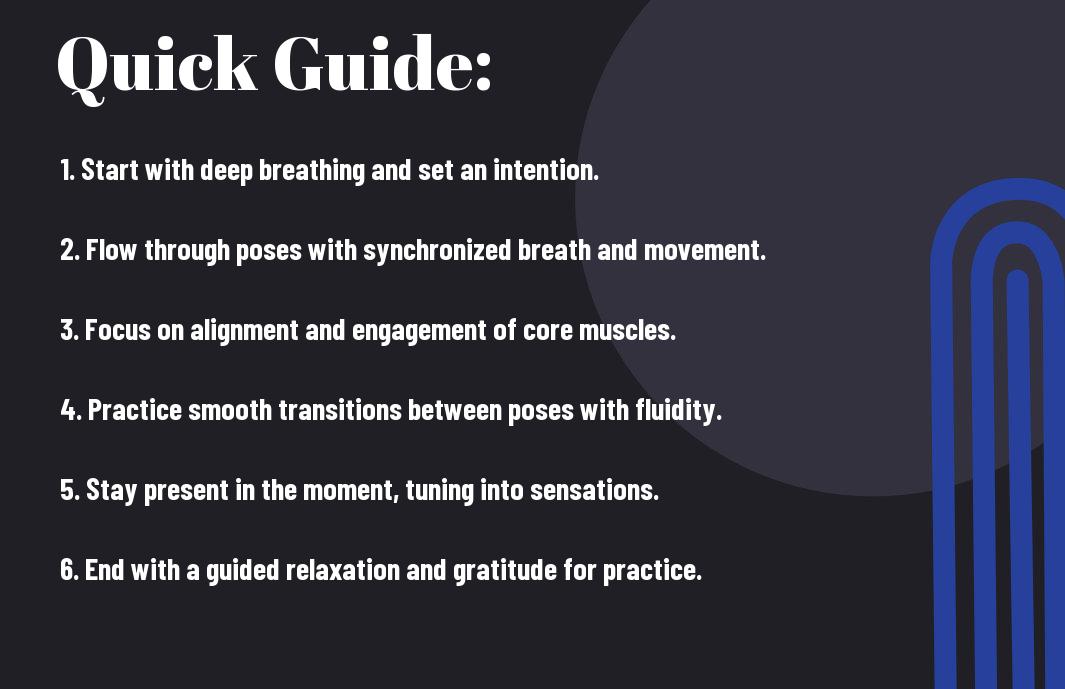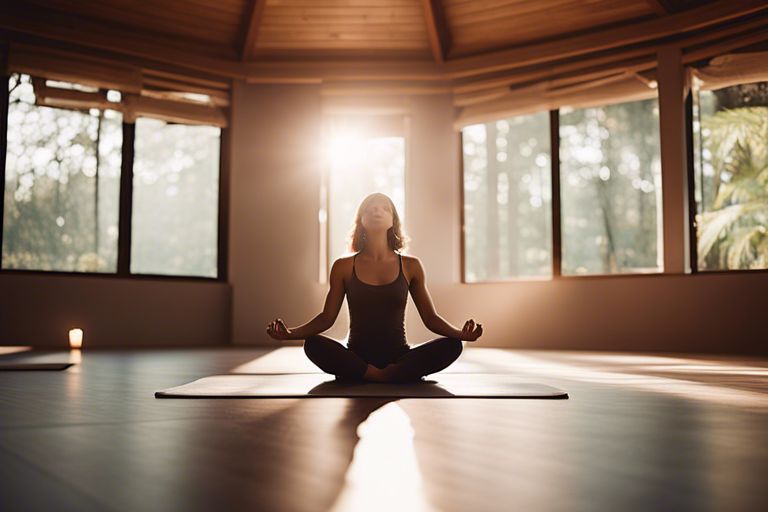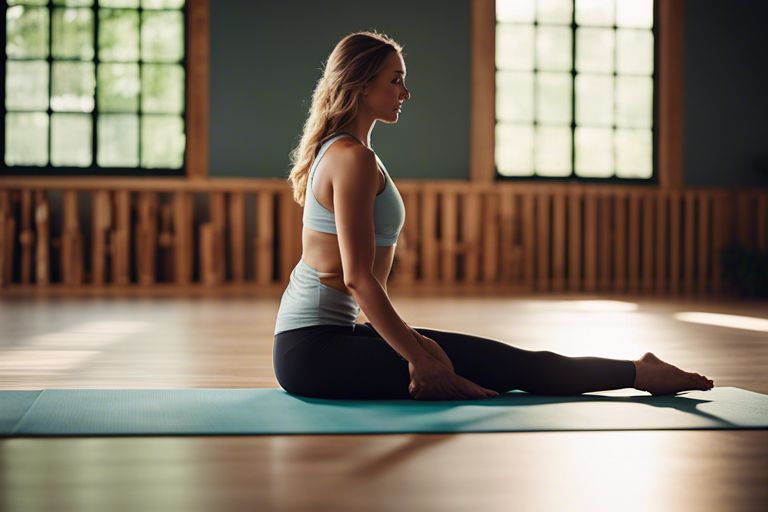This guide will help you unlock the secrets of mastering Vinyasa yoga movements while cultivating a state of mindful self-awareness. By following these clear instructions and focusing on your breath, alignment, and transitions between poses, you can deepen your practice and experience the positive benefits of this dynamic yoga style. Learn how to flow gracefully through sequences, listen to your body, and connect with your inner self on a deeper level.
Key Takeaways:
- Focus on Breath: Pay close attention to your breath throughout the practice, using deep and steady breathing to help guide your movements and connect your mind and body.
- Embrace Modifications: It’s important to listen to your body and make modifications as needed to avoid injury and ensure a safe practice. Don’t be afraid to use props or adjust poses to suit your individual needs.
- Cultivate Self-Awareness: Practice mindfulness and self-awareness during your Vinyasa yoga practice by staying present in the moment, observing your thoughts and sensations without judgment, and honoring your body’s limits.

Understanding Vinyasa Yoga
Before delving into the practice of Vinyasa yoga, it is crucial to grasp the core concepts and principles behind this dynamic and flowing style of yoga. Understanding Vinyasa yoga involves exploring its definition, origins, and the different types that exist within this popular yoga discipline.
Definition and Origins
Now, Vinyasa yoga is a style of yoga that coordinates movement with breath to flow from one pose to the next in a seamless sequence. The word “Vinyasa” can be broken down into Sanskrit roots: “nyasa” meaning “to place” and “vi” meaning “in a special way.” This definition emphasizes the intentional and mindful placement of movements in this dynamic practice. Vinyasa yoga originated from Hatha yoga traditions but has evolved to incorporate more fluid transitions and creative sequences.
Types of Vinyasa Yoga
Now, there are various types of Vinyasa yoga that cater to different intentions and practitioners. Some common types include Power Vinyasa, Slow Flow, Ashtanga Vinyasa, and Yin-Yang Vinyasa. Each type offers a unique approach to sequencing, pace, and intensity, allowing individuals to find a style that resonates with their needs and preferences. Any individual, regardless of experience level or physical fitness, can benefit from practicing Vinyasa yoga.
| Power Vinyasa | Focuses on strength-building and dynamic movements |
| Slow Flow | Emphasizes slow and mindful transitions |
| Ashtanga Vinyasa | Follows a specific sequence of poses with synchronized breath |
| Yin-Yang Vinyasa | Combines dynamic flow with longer holds in poses |
| Custom Vinyasa Sequences | Allows for personalized and creative sequences |
Preparing for Vinyasa Yoga Practice
Essential Equipment and Props
Some of the vital equipment and props you might need for your Vinyasa yoga practice include a yoga mat, a yoga block, and a yoga strap. These props can help support your practice and improve your alignment during poses. Additionally, having a water bottle nearby is crucial to stay hydrated throughout your practice.
Creating a Conducive Environment
On your journey to mastering Vinyasa yoga movements, creating a conducive environment is key. Ensure you have a quiet and clutter-free space with good ventilation and natural light. Setting up a calming playlist or using vital oils like lavender can enhance the ambiance and help you focus.
It is important to eliminate distractions such as phones and other electronics to fully immerse yourself in your practice. Creating a welcoming environment can enhance your focus and allow you to connect with your mind, body, and breath more deeply.
Tips for Beginners
Environment plays a vital role in your Vinyasa practice, especially as a beginner. Here are some tips to help you set up a conducive space:
- Choose a quiet and calm space to minimize distractions.
- Use props like blocks and straps to assist you in poses and avoid injury.
- Focus on your breath and listen to your body to prevent overexertion.
Any adjustments you make to your environment to support your practice will benefit your overall experience and progress as a Vinyasa yogi.
Mastering Basic Vinyasa Yoga Movements
All beginners in Vinyasa yoga can benefit from a structured approach to learning the basic movements. Investing in a comprehensive guide such as The Complete Guide to Master Vinyasa Yoga; Benefits … can provide valuable insights and instructions.
Step-by-Step Guide to Sun Salutations
| Step 1: | Begin in Mountain Pose, standing tall with hands at heart center. |
| Step 2: | Inhale and raise your arms overhead, arching back slightly. |
Some of the foundational poses in Vinyasa yoga include Sun Salutations, which are a sequence of movements that flow together seamlessly, promoting flexibility and strength. Practicing Sun Salutations regularly can help improve the overall flow of your Vinyasa practice.
Downward-Facing Dog and Its Variations
To ensure proper alignment in Downward-Facing Dog, start by spreading your fingers wide apart and pressing firmly into the mat with palms shoulder-width apart. Lift your hips up and back while grounding your heels towards the mat.
For instance, variations of Downward-Facing Dog can include bending one knee at a time to stretch the calves and hamstrings more deeply. It is important to engage your core muscles and focus on maintaining a straight line from your wrists to your hips in this pose.
Warrior Poses and Their Modifications
Guide your practice with Warrior Poses, such as Warrior I, II, and III. These poses help build lower body strength, improve balance, and cultivate focus and determination on the mat.
With consistent practice, you can gradually deepen the Warrior poses by extending the length of your strides or exploring arm variations. Remember to listen to your body and make adjustments as needed to find a variation that suits your current level of flexibility and strength.

Advanced Vinyasa Yoga Techniques
Many advanced vinyasa yoga practitioners seek to deepen their practice by incorporating more challenging movements and poses. Here are some advanced techniques to help you elevate your vinyasa practice:
- Inversions and Balancing Poses
There’s a sense of empowerment and mindfulness that comes with mastering inversions and balancing poses in vinyasa yoga. These poses require a strong core, steady focus, and proper alignment to achieve. Some advanced inversions like headstands or handstands can be intimidating but with consistent practice and guidance from a qualified instructor, they can be within your reach.
- Backbends and Forward Folds
Little by little, as you progress in your vinyasa practice, you may start exploring deeper backbends and forward folds. Backbends like wheel pose or camel pose can help open up the chest and shoulders, while forward folds like standing forward bend or seated forward fold can provide a calming and introspective effect on the mind.
Understanding
- Transitions and Flow Sequences
Some vinyasa yoga practitioners find joy in the fluidity and grace of transitions between poses and in flowing sequences. Mastering smooth transitions requires focus, breath awareness, and a strong connection to your body. Flow sequences like Sun Salutations or Warrior flows can help build strength, flexibility, and endurance while keeping the mind engaged and present.
Yoga
Overall, advanced vinyasa yoga techniques can challenge and inspire practitioners to explore their physical and mental boundaries. It is important to approach these advanced practices with a sense of patience, self-awareness, and respect for your body’s limits. Remember to always listen to your body, seek guidance from experienced teachers, and approach advanced techniques with mindfulness and care.
Factors Affecting Vinyasa Yoga Practice
After commenceing on your Vinyasa yoga journey, it’s important to understand the various factors that can affect your practice. From breathing techniques and Pranayama to alignment and body awareness, and flexibility and strength considerations, these elements play a crucial role in mastering Vinyasa yoga. Knowing how these factors influence your practice can help you enhance your experience and deepen your self-awareness on the mat.
Breathing Techniques and Pranayama
While practicing Vinyasa yoga, breath control plays a significant role in syncing movement with breath. Proper Pranayama techniques help in promoting mindfulness, increasing oxygen flow, and calming the mind. Focusing on the inhale and exhale during each movement can create a sense of fluidity and connection throughout your practice. Knowing how to regulate your breath can also help you navigate challenging poses with more ease.
Alignment and Body Awareness
Even subtle adjustments in alignment can make a big difference in your Vinyasa practice. Paying attention to how your body moves in each pose and being aware of muscle engagement can prevent injuries and enhance the benefits of the practice. To deepen your body awareness, try incorporating props and mirrors to observe your alignment and make necessary corrections. This heightened awareness can lead to a more mindful and safe practice.
Flexibility and Strength Considerations
To maximize your Vinyasa yoga practice, it’s vital to consider your flexibility and strength levels. Some poses may require a combination of balance, flexibility, and strength, so it’s important to gradually work on improving these areas. Body awareness is key in understanding your limitations and working towards gradual progress in both flexibility and strength.
By honing in on these key factors affecting Vinyasa yoga practice, you can cultivate a deeper mind-body connection and elevate your overall experience on the mat. Do not forget, each individual’s journey is unique, so embrace the process with patience and self-awareness.
Mindful Self-Awareness through Vinyasa Yoga
Despite the physical challenges that Vinyasa yoga presents, it is also a powerful tool for cultivating mindfulness and self-awareness. By synchronizing breath with movement, Vinyasa yoga encourages practitioners to be fully present in each pose, fostering a deep connection between mind, body, and spirit. To learn more about how to teach Vinyasa yoga for all levels, check out How to Teach Vinyasa Yoga for All Levels.
Cultivating Awareness through Meditation
Clearly, one of the most effective ways to develop self-awareness in Vinyasa yoga is through the practice of meditation. By quieting the mind and focusing on the breath, practitioners can observe their thoughts and emotions without judgment, cultivating a greater sense of clarity and presence. Through consistent meditation practice, students can deepen their awareness of their inner selves and enhance their overall well-being.
Developing Body Awareness and Intuition
Body awareness is a key component of self-awareness in Vinyasa yoga. As students flow through sequences of poses, they learn to listen to their bodies and respond to their needs intuitively. By paying attention to physical sensations and aligning movements with the breath, practitioners can develop a profound understanding of their bodies and cultivate a sense of inner wisdom.
Yoga teaches us to trust our bodies and listen to the messages they send us. By honing our body awareness and intuition on the mat, we can carry these skills into our daily lives, making more conscious choices that align with our true selves.
Integrating Self-Awareness into Daily Life
Yoga is not just a practice confined to the mat; it is a way of life that extends into every aspect of our being. By integrating self-awareness into our daily lives, we can approach challenges with a greater sense of clarity and compassion. Through mindful awareness of our thoughts, emotions, and actions, we can cultivate a deeper connection to ourselves and the world around us.
With a commitment to self-awareness and a regular Vinyasa yoga practice, we can tap into our true potential and live more authentic, fulfilling lives.
Summing up
From above, mastering Vinyasa yoga movements requires practice, alignment, and breath awareness. Following instructions for mindful self-awareness can enhance the benefits of this dynamic practice. By focusing on alignment, breath, and mindfulness, practitioners can deepen their practice and experience a more profound connection to body, mind, and spirit.
Remember to approach Vinyasa yoga with patience and compassion towards yourself. By committing to the practice and incorporating these instructions, you can cultivate a stronger mind-body connection and a deeper sense of self-awareness. Embrace the flow, honor your body, and enjoy the journey of mastering Vinyasa yoga movements for a more fulfilling practice.
FAQ
Q: What is Vinyasa Yoga?
A: Vinyasa Yoga is a dynamic form of yoga that links movement with breath. It focuses on coordinating movement and breath to flow from one pose to another. This style is often referred to as flow yoga, as the poses are practiced in a smooth sequence.
Q: How can I master Vinyasa Yoga movements?
A: To master Vinyasa Yoga movements, it is important to focus on your breath and alignment. Practice regularly and pay attention to the transitions between poses. Take your time to understand the sequence and listen to your body. Consistency and mindfulness will help you improve your practice and master the movements.
Q: How can I practice mindful self-awareness during Vinyasa Yoga?
A: Mindful self-awareness during Vinyasa Yoga involves being present in the moment and listening to your body. Focus on your breath and sensations as you move through the poses. Notice any thoughts or emotions that arise without judgment. Cultivating self-awareness can deepen your practice and help you stay connected to yourself on and off the mat.











